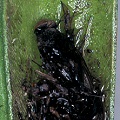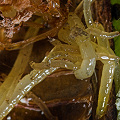Q: How do carnivorous plants digest their prey?

S. flava contents

That's gotta hurt!

Metriocnemus
A: Carnivorous plants must have use enzymes to digest their prey.
Most carnivorous plants, such as Venus flytraps, sundews, butterworts, and
many genera of pitcher plants all make their
own digestive enzymes. After their captured meals have been digested, all that remains
is a
sickening mass of crunchy bits that will put you off popcorn for a
long time. (More because of the the texture than the flavor.)
Other carnivorous plants (such as Heliamphora)
rely on bacteria to produce the appropriate
enzymes. In this case, the plants themselves do not excrete the digestive
juices. The food just rots, and the carnivorous plants absorb the
decomposed molecules. Many plants, such as Sarracenia (and notably
Sarracenia purpurea) rely upon both their own enzymes and
bacterially generated enzymes. This is called a symbiotic (or mutualist)
relationship, because both organisms benefit from the cooperation. The plant
enjoys the bug-soup digested by the bacteria, while the bacteria get a nice
place to live.
Incidentally, as I have noted earlier in the FAQ, bacterial symbioses are common
in the animal world--termites have
bacteria in their guts that enable them to digest wood, and humans have
E. coli in their guts to help them with their
digestion.
A third trick that some carnivorous plants use is arthropods such as insects such as hemipterans like
Pameridea or Setocoris (commonly misspelled as
"Setocornis") or
midge larvae (Metriocnemus sp.).
A famous case involves critters called assassin bugs that
live on carnivorous Byblis, Drosera
and Roridula.
These assassin bugs crawl around on the carnivorous plant
and eat the poor insects that have been captured. It is amazing the
assassin bugs do not get caught themselves. The bugs then poop,
and the excrement is absorbed by the plant. Yum yum! Bug poop!
As I note elsewhere in the FAQ, some people question if the plants that
rely upon bacteria or arthropods to help them perform digestion
should really be called "carnivorous," and should be called
something else like "paracarnivorous." I doubt there is any
resolution to this tedious discussion. Nature presents us with a continuum
of processes, and trying to classify the Universe into clear-cut categories is not
always fruitful. Black and white distinctions only occur in the Star Wars1
movies, and not reality.
Perhaps the most horrible of all the adaptations in the world of carnivorous plants and their
allies, are the lifestyles adopted by
some species of Nepenthes. These may function
as places where birds
poop. The produce food for the birds (little globs of goo tasty to avifauna). While the
birds sup, they poop.
The poop slides or drains into the pitcher for consumption by the
plant. Nothing like
a little flavorful, gooey bird doo-doo to get you going in the morning.
(If this is correct, the acronym "ICPS" for our beloved carnivorous
plant society does not have to be changed. It could just stand for
"International Coprophagous Plant Society"!)
1I hope this reference to Star Wars satisfies those people who complain that I
only make Star Trek or Lovecraft references in the FAQ, and that I
do not make suitable
obeisances to Yoda (who Spock could whup any day of the week) or
young Mr. Skywalker
(Luke vs. Kirk?...not too hard to figure out the winner in that one either!
One Federation karate chop and it would be all over for li'l Jedi boy!).
Page citations: Clarke, C. 1997, 2001; Frazier, C. 2000;
Gallie, D.R. & Chang, S.C. 1997; Hartmeyer, S. 1997, 1998;
Juniper, B.E. et al. 1989; Rice, B.A. 2006a.